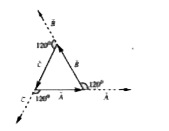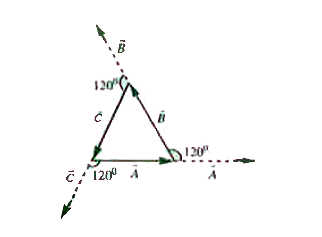If A,B,C represents the three sides of an equilateral triangle taken in the same order then find the angle between i) A and B ii) B and C iii) A and C.

From the diagram the angle between the vectors A and B is 120°, the angle between B and c is 120°, the angle between A andc is 120°
Topper's Solved these Questions
- MOTION IN A PLANEBOOK - AAKASH SERIESCHAPTER - MOTION IN A PLANEEXERCISE - SHORT ANSWER TYPE QUESTIONS
6 Videos
- MOTION IN A PLANEBOOK - AAKASH SERIESCHAPTER - MOTION IN A PLANEEXERCISE - VERY SHORT ANSWER TYPE QUESTIONS
10 Videos
- MOTION IN A PLANEBOOK - AAKASH SERIESCHAPTER - MOTION IN A PLANEEXERCISE - EXERCISE-3 (Circular Motion)
7 Videos
- MOTION IN A STRAIGHT LINE BOOK - AAKASH SERIESCHAPTER - MOTION IN A STRAIGHT LINE EXERCISE - very Short answer type question
15 Videos
Similar Questions
If →A,→B,→C represents the three sides of an equilateral triangle taken in the same order then find the angle between (i) →Aand→B(ii)→Band→C(iii)Aand→C.

View SolutionIn an equilateral triangle ABC if AD⊥BC , then
View SolutionIf →a, →b, →c represent the sides of a triangle taken in order, then write the value of →a+→b+→c
View SolutionIn Figure, ABC is an equilateral triangle. Find m ∠BEC
View SolutionFig. shows wave patterns of three sounds A, B and C. Name the characteristic of sound which is the same between (i) A and B, (ii) B and C, and (iii) C and A.

View SolutionIf →a,→band→c represents three sides of a triangle taken in order prove that
→a×→b=→b×→c=→c×→a
View SolutionIn an equilateral triangle ABC the side BC is trisected at D . Prove that 9 AD2=7 AB2
View SolutionGiven, A = {Triangles}, B = {Isosceles triangles}, C = {Equilateral triangles}. State whether the following are true or false. Give reasons.
(i) A⊂B, (ii) B⊆A, (iii) C⊆B, (iv) B⊂A, (v) C⊂A, (vi) C⊆B⊆A
View SolutionShow that the sum of the three altitudes of a triangle is less than the sum of three sides of the triangle. GIVEN :triangle A B C in which AD⊥BC,BE⊥AC and CF⊥AB. PROVE : AD+BE+CF<AB+BC+AC
View SolutionThree concentric spherical metallic shells A, B and C of radii a, b and c (a < b < c) have surface charge densities σ, −σ and σ respectively.
(i) Find the potential of the three shells A, B and C.
(ii) If the shells A and C are at the same potential, obtain the relation between the radii a, b and c.
View Solution
